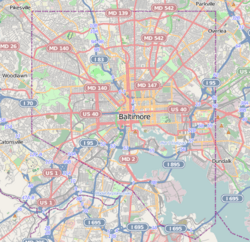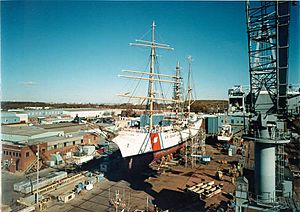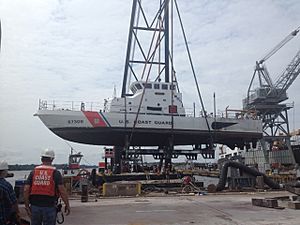United States Coast Guard Yard facts for kids
Quick facts for kids |
|
|
U.S. Coast Guard Yard Curtis Bay
|
|

Coast Guard Yard showing USCGCs Dependable, Abbie Burgess, Willow, and Tybee
|
|
| Nearest city | Baltimore, Maryland |
|---|---|
| NRHP reference No. | 83002924 |
| Added to NRHP | August 05, 1983 |
The United States Coast Guard Yard, often called the Coast Guard Yard, is a special shipyard run by the United States Coast Guard. It's located on Curtis Bay in northern Anne Arundel County, Maryland, just south of Baltimore. This yard is the biggest industrial place in the Department of Homeland Security.
It's the only place where the Coast Guard builds new ships and does major repairs on its fleet. The yard is a key part of how the Coast Guard keeps its ships ready. It handles everything from engineering and logistics to maintenance, making sure ships are supported throughout their entire life.
Contents
History of the Coast Guard Yard
Starting Out: 1899-1919
The Coast Guard Yard has been building, fixing, and updating ships for the U.S. Coast Guard since 1899. It's the only facility of its kind for the service. The yard was set up near Curtis Creek and Curtis Bay in southern Baltimore and northern Anne Arundel County.
In April 1899, the old United States Revenue Cutter Service (RCS) rented about 36 acres of land around Arundel Cove. Soon after, Lieutenant John C. Moore arrived to start the shipyard. He set up four small buildings, including a lumber mill. The next year, the training ship Salmon P. Chase arrived, and its crew set up permanent homes. This also marked the beginning of the United States Coast Guard Academy.
In 1905, the United States Congress allowed the Coast Guard to buy the land the depot was on, along with more nearby properties. This ended the rental agreements. In its first ten years, the yard fixed many lifesaving boats, built small boats, and worked on larger RCS cutters. The yard's facilities kept getting better during the 1910s. New buildings included a boiler house, a foundry, and shops for boats, sheet metal, and electrical work. There were also new mess halls, barracks, and storage buildings.
In 1915, the Revenue Cutter Service and the Lifesaving Service joined to form the U.S. Coast Guard. The yard was chosen to train surfmen (people who work on lifeboats) how to use gasoline engines.
Growing and Helping in Wars: 1919-1949
In the 1920s, the yard made more boats, canvas items, and other things the Coast Guard needed. They did big repairs on modern ships like Yamacraw and Seneca, plus many patrol boats and tugs. About 500 people worked at the depot, including civilian employees and military members.
By the 1930s, many of the original buildings and tools were old. So, new boat, gas engine, and machine shops were built. A 40-ton marine railway was also put in place. When the United States Lighthouse Service joined the Coast Guard in 1939, building buoys became another important job for the yard.
When World War II started, the yard grew a lot. They added a 3000-ton floating drydock and two shipways. The yard, now similar in size to a medium-sized navy shipyard, was officially named the U.S. Coast Guard Yard. Workers repaired vessels, including submarines, made buoys, produced canvas items, and built over 300 small wooden boats each year. They also built the biggest cutters ever made at the yard: the 255-foot cutters Mendota and Pontchartrain. During the war, 3100 civilian workers were employed here.
Post-War and Modern Ships: 1949-1979
After the war, the yard reduced its workers to fit the Coast Guard's needs. Their main jobs included ship overhauls, gun repairs, buoy building, and making various other items. In the 1950s, they built three hundred 40-foot steel lifesaving patrol boats. They also built the Coast Guard lightships San Francisco and Ambrose, and small craft like the 36-foot motor lifeboats.
In February 1953, the first of the 95-foot steel patrol boats was launched. In total, 58 of these 95-footers were built for the Coast Guard and Navy. The yard became known for fixing up older Coast Guard and Navy ships. In March 1958, the Coast Guard Cutter Azalea, a 100-foot buoy tender, was launched.
The first of 53 cutters built under the 82-foot patrol boat program was launched in February 1960. During the Vietnam War, 26 of these 82-footers served with Coast Guard Squadron One. In April 1962, the first 44-foot steel self-righting motor lifeboat (MLB) was launched. The yard built 110 of these 44-foot MLBs over the next ten years.
In May 1965, the yard launched its first 210-foot USCG Medium Endurance Cutter, Confidence. Other 210-foot cutters like Resolute were also built here. During the 1960s, the yard built five 157-foot buoy tenders. They also built 206 25-foot fiberglass motor surfboats.
The 1970s were very busy for the yard. They continued making lighted buoys, a program that started during World War II. These included large steel buoys for navigation and lighted ice buoys for icy conditions. Starting in 1975, the yard became the only place to overhaul the Coast Guard's 5-inch 38 caliber gun mounts. These guns were used on the service's 378-foot cutters.
In 1971, the yard finished building a prototype 41-foot utility boat (UTB) with an aluminum hull. From 1973 through the early 1980s, the yard built 207 of these 41-foot UTBs. This boat is well-known and used mainly for search and rescue. The yard also built the prototype Stable Semi-Submerged Platform, or SSP, called Kailmalino. This craft used a special design called SWATH (Small Waterplane Area Twin Hull).
In 1974, the yard started building a 160-foot construction tender, the CGC Pamlico. Three more 160-foot tenders were built: the CGC Hudson, CGC Kennebec, and CGC Saginaw. From the late 1970s into the early 1980s, the yard updated sixteen 95-foot patrol boats that were originally built there in the 1950s.
Modern Era: 1979-Present
In the 1980s, the yard built a prototype oil skimmer to help clean up oil spills. The first of the new 270-foot medium endurance cutters, the Bear, arrived in 1983 for final work and electronics. The yard also updated 12 other 270-foot cutters.
Starting in 1984, the yard began a Service Life Extension Program (SLEP) for nine 180-foot buoy tenders. This renovation gave them about 20 more years of service. In 1984, the yard also put the first 210-foot medium endurance cutter back into service after major upgrades. Eleven more vessels would be renovated through the 1990s.
In 1985, the yard finished a big renovation of a ferryboat for Coast Guard use in New York. The Kulshan, a 30-year-old vessel, was renamed the Governor after its renovation. As the 1980s ended, the Coast Guard asked the yard to build six river barges for use on the Mississippi and Missouri Rivers.
In 1983, the U.S. Coast Guard Yard at Curtis Bay was added to the National Register of Historic Places.
After a four-year repair project on the Coast Guard Cutter Barque Eagle in the 1980s, the cutter returned for more repairs in 1995 and 1998. The yard also built 26 small aids-to-navigation workboats, called 49-foot BUSLs, until the year 2000. The first BUSL was launched in August 1997.
In October 1998, the yard finished the 210-foot Major Maintenance Availability Program. Fourteen of the Coast Guard's 210-foot cutters went through an 18-month, $21 million renovation at the yard. With a new $18 million shiplift in November 1997, the yard could repair even more Coast Guard vessels. This new land-based system replaced the old drydocks and is better for the environment.
The yard is the only place for major repairs of naval weapon systems used by the Coast Guard. This includes fixing the MK 75 76 mm guns. The yard also started overhauling the Paxman engine, which is the main engine in the 110-foot patrol boat. The yard is known for bringing its skills to the Coast Guard fleet around the world. In 1995, the yard became the first U.S. government organization to get ISO 9001 certification, which means it meets international standards for quality management.
![]() This article incorporates public domain material from the United States Government document "US Coast Guard Yard".
This article incorporates public domain material from the United States Government document "US Coast Guard Yard".
- United States Coast Guard Yard, Anne Arundel County, including photo from 1944, at Maryland Historical Trust




